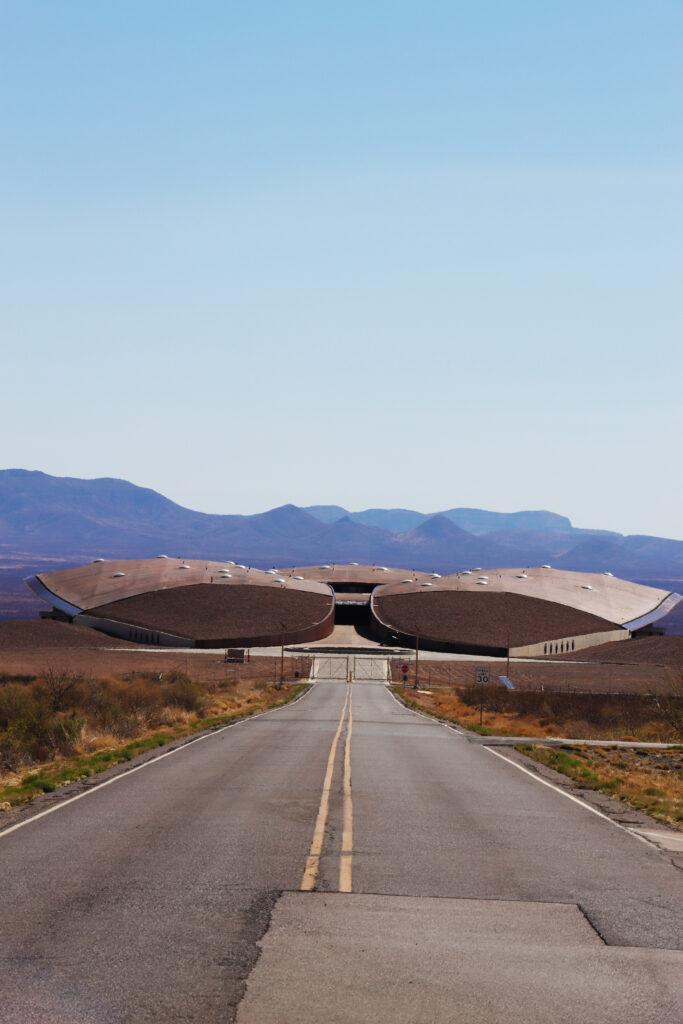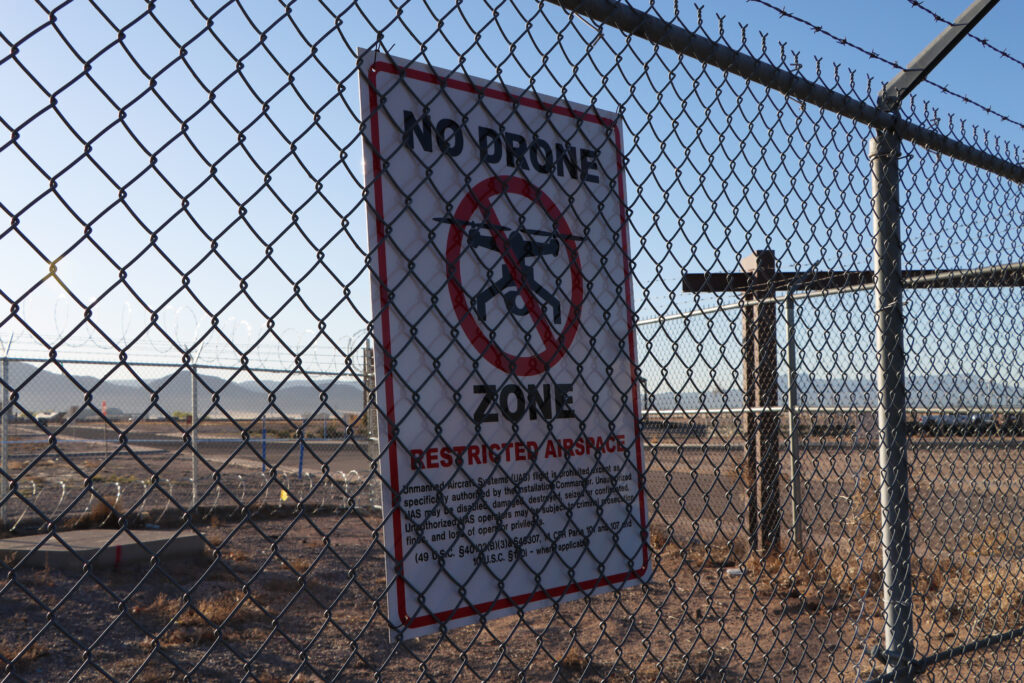Roughly translated as “Daytrip of the Dead Man,” The Jornada del Muerto is an exceptionally dry 90-mile stretch of the Chihahuan desert, set between four distinct mountain ranges in southern New Mexico. This footpath received its modern name when it became a part of the Camino Real de Tierra Adentro, the highway of Spanish colonization that connected Sante Fe to Mexico City. Attempts to farm the desert basin over the last century were abandoned because of the difficulty of obtaining water. In the early 1940s, a site at the desert’s northern end was deemed sufficiently desolate to serve as the location of the first atomic bomb test. So-called “Trinity Downwinders,” who lived south of the Jornada and named themselves after the test site, are still fighting to be compensated for the medical and environmental issues linked to the blast.
Today, the Jornada del Muerto is largely uninhabited, and devoid of any significant human structures. At a spot in the central Jornada, at the end of a narrow asphalt road, however, sits a notable exception. Spaceport America is the “first purpose-built commercial spaceport in the world.” It hopes to launch regular tourist flights into orbit by the year 2026. Spaceport America’s main tenant is Virgin Galactic, an offshoot of billionaire Richard Branson’s Virgin Group. Branson was among the first to reach suborbital space from Spaceport America’s New Mexico launchsite late last year. Hisflight kicked off a new billionaire space race beating Amazon founder, and richest person in the world, Jeff Bezos’ own flight into orbital space by nine days.
On a cloudless spring day, the Spaceport’s main building sits like a hypermodern clamshell gleaming with glass and lights. A scheduled open house has been canceled due to high winds; a friendly security guard in a vaguely tactical uniform controls the entryway. At this moment, Spaceport America feels like a vanity project, underused and opulent. Space itself, however, is getting crowded.

“People think space is infinite,” says Timiebi Aganaba, a space lawyer at the University of Arizona and part of the Outer Space Institute. The opposite is true, she explains: “the useful parts are a limited resource.” While crewed missions like the well-publicized billionaire launches draw the lion’s share of attention, the vast majority of rocket launches today are uncrewed missions transporting satellites into orbit. These launches are increasing at a staggering rate; roughly 4,500 active satellites that are currently in orbit may become as many as 100,000 within the next decade. The majority of these will circle in low earth orbit – an altitude of 2,000 kilometers or lower – as part of massive “mega-constellations” of communications satellites. Many of these will be visible to the naked eye, artificially brightening night skies. The Tesla project “Starlink” alone is currently launching up to 60 satellites at a time, several times a month. “We’re at a grab right now,” says Aganaba when describing the competition for orbits.
Traditionally, space has been a domain of nation states and militaries. The “space race” between the United States and the Soviet Union served as a stage for nationalist ambitions and as a scientific proving ground. This distribution of power has shifted with the advent of more affordable technologies for building and launching satellites. Many of the sensors and chips that once made the construction of a satellite prohibitively expensive can today be found in the average smartphone. It is becoming, in Aganaba’s words, a “multi-stakeholder environment.” From research institutions, to corporations, to the many nation states that were traditionally locked out of space exploration because of the price tag.
This is not to say that the US military has ceded its dominance over space. At the close of 2019, then-president Trump established the Space Force, an entirely new branch of the military dedicated to orbit and beyond. Widely parodied for early publicity missteps and its connection to the end of his presidency, the inception of the Space Force was the culmination of long-standing bipartisan efforts. Highlighting this, the Biden administration recently increased the new force’s annual budget by 30 billion dollars.
The very first satellites were developed in parallel with weapons that could destroy them. The practice of intercepting objects in orbit as part of the testing of intercontinental ballistic missiles spans back into the 1950s and 60s–the early stages of the space race. Some of these weapons are lightly modified intercontinental ballistic missiles, adapted to the destruction of satellites rather than targets on the ground. Other systems are considered satellites themselves, and are capable of approaching and attacking their targets via their orbital flightpath. The Russian satellite Cosmos 2543 has been nicknamed the “nesting doll” for its capability of deploying numerous smaller satellites from within its body, which can then autonomously engage enemy spacecrafts. Another category of anti-satellite weapons is designed to hamper satellite functions rather than destroying them outright. Russia, China and the US have all been experimenting with so-called “dazzlers,” high-intensity lasers that have the capability to blind optical lenses and other sensors.
Kirtland Air Force Base is one place where these weapons are being developed. Built shortly after the end of World War II and sprawling across most of the southeastern edge of Albuquerque, New Mexico, it is now also home to Space Force personnel.
Although Kirtland is part of Albuquerque, much of what happens there is entirely outside of the public view. Research projects taking place at Kirtland now fall under the purview of the Space Force are for “directed energy” weapons.

The workforce at Kirtland is roughly split between civilian contractors and military personnel. This mirrors the overall make-up of the new military branch, as well as its orientation towards private space companies. “Leverage the advantage” is how the Space Force’s leader, General John Raymond describes its relationship with the private sector. This interweaving of military and private interests reaches from research all the way into orbit. Many military satellites will be launched into their flight paths not on government rockets, but by those of SpaceX and Blue Origin, the latter being the space exploration company founded and owned by Amazon. Rather than building its own launchpads, rockets and other expensive installations necessary to launch, many of the Space Force assets will simply piggyback on the rocket flights of contractors. This can be immensely profitable for these corporations, as the sensitive nature of the payloads allows them to charge a premium for their services. The launch of a Space Force satellite can net twice the fee for comparable civilian cargo.
The pace of development begs the question of an endgame. “If SpaceX launch all their satellites, they are going to appropriate the entire orbit,” says Aganaba, who has worked with the Nigerian space program. “The person that comes first gets to dominate how it gets used – from a developing country perspective, I have equity issues with that.”
One cost of space development that is already being borne out is environmental. NASA has identified and is continually tracking over 27,000 individual pieces of space debris. Some of these pieces of space junk are the remnants of scientific space exploration, others are the relics of weapons testing. The number of smaller pieces reaches into the hundreds of thousands. Each of these can have potentially fatal consequences for space flights because of the speeds involved. Both rockets and space debris travel at speeds north of 25,000 kilometers per hour, enough to turn old rocket fuselages into deadly projectiles.
Katarina Damjanov, a researcher and lecturer at the University of Western Australia, has thought extensively about the consequences of space debris. She strikes a pessimistic tone in describing the new paradigm. “I think we are likely to see some kind of orbital war in the near future.” Damjanov deems companies like SpaceX to represent a “state-funded private sector,” which will ultimately prove to be even more dangerous to the ideal of space as an open place than the effort of state militaries to load it with weapons.
Nation-states, Damjanov explains, “need to be reasonable enough not to destroy everything” in space. Private companies, however, are not bound by the same concerns of long-term international cooperation. Obsolete private satellites, or even entire networks that are deemed financially unviable will simply remain in orbit. Private ventures aren’t bound by a desire to remain part of the community of nations, says Damjanov, nor are there rules that require cleaning up what is launched into space, “It’s pure profit.”To Damjanov, the increasing competition for usable space isn’t likely to end well. She describes the prevailing attitude as “launch now, ask later.” She compares the legal environment in space to the cliché of the Wild West: “Who is going to stop Elon Musk from launching?”
Space is lawless, and it is this lack of rules that many experts see as being at the heart of the issue. There are agreements and informal rules in place, “but there is no specific document that says what the law is from a neutral perspective,” says Ram Jakhu. Jakhu has been studying the legal parameters of space for decades, and is currently leading the effort to create a manual for military conduct in outer space. The Manual on International Law Applicable to Military Uses of Outer Space, or “MILAMOS” is set to publish its first within the next few weeks.
“It’s a very tedious job,” Jakhu says of the project. “It’s complex, because we are not only looking at the law, but at technology.” In order for MILAMOS to create guidelines for the use of weapons in space, it must in some cases first define what a weapon is. This is a particularly thorny question in the orbital environment, where even a small piece of debris can seriously damage or destroy. Jakhu is hopeful that the project’s recommendations will serve as a guideline to ultimately moderate the use of military force. While the project ’includes observers from state militaries, its resulting guidelines ultimately will not have the force of law. To Jakhu, much of the success of MILAMOS should be measured by the attention it can garner for the issues it raises about weapons testing and military conflicts in space. “The rationale for the project is to show the public what is at stake.”
Jurists like Jakhu and Aganba see the future of open space as being secured through legal mechanisms, but those will hinge on the participation of the most powerful players. Jahkhu points to the recent declaration on the part of the Biden administration to cease the testing of some forms of anti-satellite weapons as an indication that the willingness is there – at least among nation states.
Conversations about space can seem abstract, and are often thick with metaphors. Everett Dolman, a leading US strategist on war in orbit has compared it to the high seas, and called for a military doctrine inspired by naval warfare. Damjanov has examined space from the perspective of the “commons.” In addition to these comparisons aimed at bringing a far place near, space serves as a place of projection Aganba, a self-described “space enthusiast,” says the current era of space exploration is marked with “worry and excitement.”

As much as their aspirations for space may differ, all experts interviewed for this story were in agreement on one point: an orbital war would spell calamity for life on earth. “If there is a war in space, the consequences are going to be enormous, unprecedented in human history,” says Jakhu. The number of systems on earth that are partially or fully dependent on satellite technology is nearly endless. Beyond providing weather data, communication services and positioning information, satellites are vital links in the international banking system, the delivery of electricity, and even in the functioning biometric medical devices.
Because of the debris fields it would create, even the destruction of only a few satellites could have catastrophic consequences. However, Damjanov points out that many of the measures that are now in use and or development don’t need to destroy satellites to be effective. Rather, a manipulation of satellite data may prove to be even more effective. “Satellites synchronize global time,” Damjanov explains over a Zoom call from Australia, “Mobile phones, computers, all time in the world is linked to them.”
Damjanov raises this question in the context of Russian and Chinese efforts to create separate alternatives to the Global Positioning System (GPS), which would be entirely under the control of their respective states. Russia has already proven that it is capable of manipulating the GPS data received by devices during military operations in Syria, and in the first invasion of eastern Ukraine. In China, a planned constellation known tentatively as “Guowang” will include 13,000 satellites, and will presumably run under close state supervision. An entirely separate satellite internet with its own state-sanctioned Geolocation data could extend the so-called “Great Firewall” of censorship content all the way into orbit.
“Information is power,” reminds Jakhu. An indelible amount of information is now transmitted via orbital space. Access to broadband internet is still distributed unevenly and inequitably around the world. The potential upsides of satellite internet like the kinds envisioned by Tesla’s Starlink or Amazon’s Kuiper could be tremendous. However, this scenario relies on the assumption that these companies will be more responsible with user data and the environment in space than they are here on earth.
In the Jornada del Muerto, Spaceport America is closed to the public. The site’s website promises a “rocket friendly environment of 6,000 square miles of restricted airspace” as well as “about 340 days of sunshine and low humidity.” Some of the construction of the spaceport was funded via a special tax, much of its operating costs are paid by the state of New Mexico, one of the poorest in the US. In Truth or Consequences, the closest population center, almost a third of residents live below the poverty line. A quaint and colorful town center is largely abandoned. The benefits of the spaceport here seem as remote as the destinations and individuals it is meant to serve.
Johannes Streeck is a freelance journalist with a focus on the southwestern US



